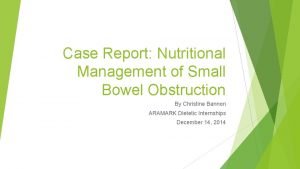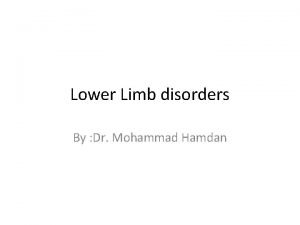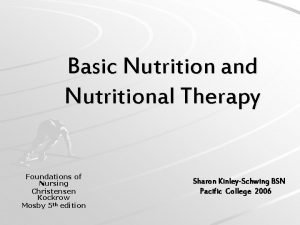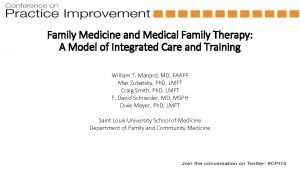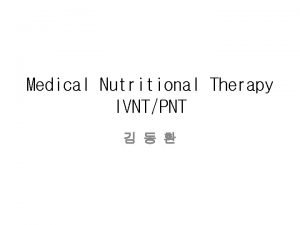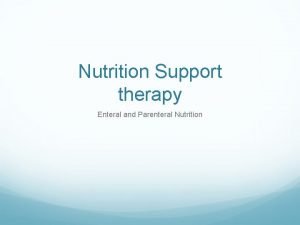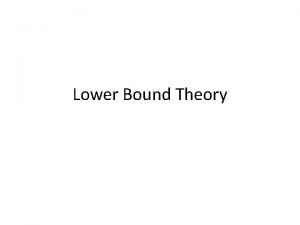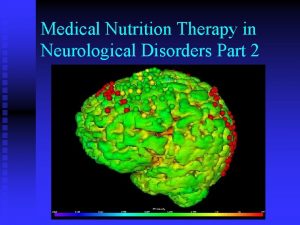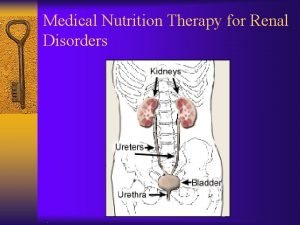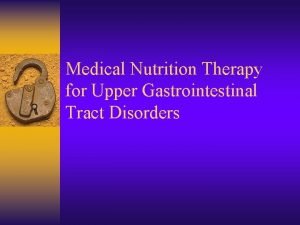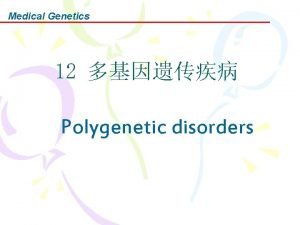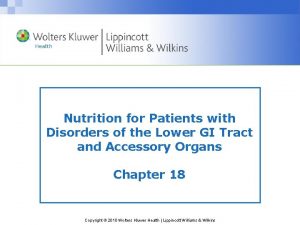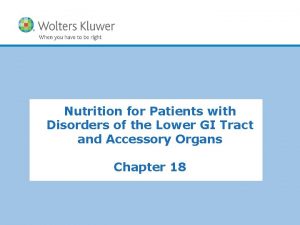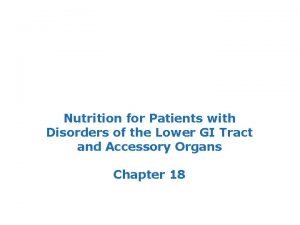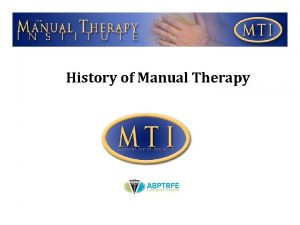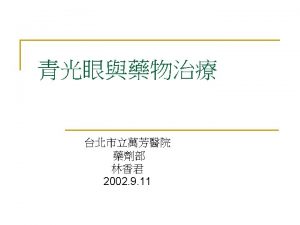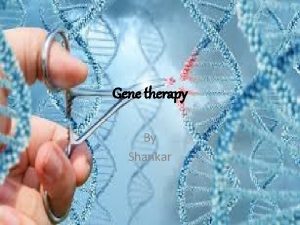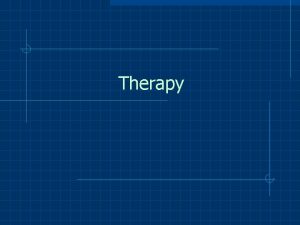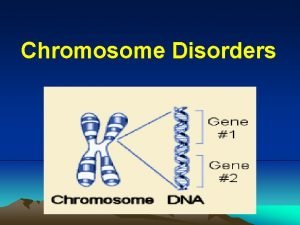Medical Nutrition Therapy for Disorders of the Lower


















































































- Slides: 82

Medical Nutrition Therapy for Disorders of the Lower Gastrointestinal Tract

Normal Function of Lower GI n Digestion n Absorption n Excretion

Normal Function of Lower GI n Digestion – Begins in mouth & stomach – Continues in duodenum & jejunum – Secretions: • Liver • Pancreas • Small intestine

Normal Function of Lower GI n Absorption – Most nutrients absorbed in jejunum – Small amounts of nutrients absorbed in ileum – Bile salts & B 12 absorbed in terminal ileum – Residual water absorbed in colon

Principles of Nutritional Care n Intestinal disorders & symptoms: – Motility – Secretion – Absorption – Excretion

Principles of Nutritional Care n Dietary modifications – To alleviate symptoms – Correct nutritional deficiencies – Address primary problem – Must be individualized

Common Intestinal Problems n Intestinal gas or flatulence n Constipation n Diarrhea n Steatorrhea Photo courtesy http: //www. drnatura. com/

Constipation n Defined as hard stools, straining with defecation, infrequent bowel movements n Normal frequency ranges from one stool q 3 days to 3 times a day n Occurs in 5% to more than 25% of the population, depending on how defined

Causes of Constipation - Systemic n Side effect of medication, esp narcotics n Metabolic Endocrine abnormalities, such as hypothyroidism, uremia and hypercalcemia n Lack of exercise Ignoring the urge to defecate Vascular disease of the large bowel Systemic neuromuscular disease leading to deficiency of voluntary muscles Poor diet, low in fiber Pregnancy n n n

Causes of Constipation Gastrointestinal n Diseases of the upper gastrointestinal tract – Celiac Disease – Duodenal ulcer n – Gastric cancer – Cystic fibrosis Diseases of the large bowel resulting in: – Failure of propulsion along the colon (colonic inertia) – Failure of passage though anorectal structures (outlet obstruction) n n n Irritable bowel syndrome Anal fissures or hemorrhoids Laxative abuse

Treatment of Constipation n Encourage physical activity as possible n Bowel training: encourage patient to respond to urge to defecate n Change drug regimen if possible if it is contributory n Use laxatives and stool softeners judiciously n Use stool bulking agents such as psyllium (metamucil) and pectin

MNT for Constipation n Depends on cause n Use high fiber or high residue diet as appropriate n If caused by medication, may be refractory to diet treatment

Fiber, roughage, and residue n Fiber or roughage • From plant foods • Not digestible by human enzymes n Residue • Fecal contents, including bacteria and the net remains after ingestion of food, secretions into the GI tract, and absorption

High-Fiber Diets n Most Americans = 10 – 15 g/day n Recommended = 25 g/day n More than 50 g/day = no added benefit, may cause problems

High-Fiber Diet n Increase consumption of whole-grain breads, cereals, flours, other whole-grain products n Increase consumption of vegetables, especially legumes, and fruits, edible skins, seeds, hulls n Consume high-fiber cereals, granolas, legumes to increase fiber to 25 g/day n Increase consumption of water to at least 2 qts (eight 8 oz cups)

High-Fiber Diets: cautions n Gastric obstruction, fecal impaction may occur when insufficient fluid consumed n With GI strictures, motility problems, increase fiber slowly (~1 mo. ) n Unpleasant side effects – Increased flatulence – Borborygmus – Cramps, diarrhea

Diarrhea n Characterized by frequent evacuation of liquid stools n Accompanied by loss of fluid and electrolytes, especially sodium and potassium n Occurs when there is excessively rapid transit of intestinal contents through the small intestine, decreased absorption of fluids, increased secretion of fluids into the GI tract

Diarrhea Etiology n Inflammatory disease n Infections with fungal, bacterial, or viral agents n Medications (antibiotics, elixirs) n Overconsumption of sugars n Insufficient or damaged mucosal absorptive surface n Malnutrition

Diarrhea Treatment for Adults n Identify and treat the underlying problem n Manage fluid and electrolyte replacement using oral glucose electrolyte solutions (see WHO guidelines) n Initiate minimum-residue diet n Avoid large amounts of sugars and sugar alcohols n Prebiotics in modest amounts including pectin, oligosaccharides, inulin, oats, banana flakes n Probiotics, cultured foods and supplements that are sources of beneficial gut flora

Low- or Minimum Residue Diet n Foods completely digested, well absorbed n Foods that do not increase GI secretions n Used in: – Maldigestion – Malabsorption – Diarrhea – Temporarily after some surgeries, e. g. hemorrhoidectomy

Foods to Limit in a Low- or Minimum Residue Diet n Lactose (in lactose malabsorbers) n Fiber >20 g/day n Resistant starches – Raffinose, stachyose in legumes n Sorbitol, mannitol, xylitol >10 g/day n Caffeine n Alcohol, esp. wine, beer

Restricted-Fiber Diets n Uses: – When reduced fecal output is necessary – When GI tract is restricted or obstructed – When reduced fecal residue is desired

Restricted-Fiber Diets n Restricts fruits, vegs, coarse grains n <10 g fiber/day n Phytobezoars – Obstructions in stomach resulting from ingestion of plant foods – Common in edentulous pts, poor dentition, with dentures – Potato skins, oranges, grapefruit

MNT for Infants and Children n Acute diarrhea most dangerous in infants and children n Aggressive replacement of fluid/ electrolytes n WHO/AAP recommend 2% glucose (20 g/L) 45 -90 m. Eq sodium, 20 m. Eq/L potassium, citrate base n Newer solutions (Pedialyte, Infalyte, Lytren, Equalyte, Rehydralyte) contain less glucose and less salt, available without prescription

MNT for Infants and Children n Continue a liquid or semisolid diet during bouts of acute diarrhea for children 9 to 20 months n Intestine absorbs up to 60% of food even during diarrhea n Early refeeding helpful; gut rest harmful n Clear liquid diet (hyperosmolar, high in sugar) is inappropriate n Access American Academy of Pediatrics Clinical Guidelines http: //aappolicy. aappublications. org/cgi/reprint/ pediatrics; 97/3/424. pdf

Diseases of Small Intestine n Celiac disease n Brush border enzyme deficiencies n Crohn’s disease

Celiac Disease n Also called Gluten-Sensitive Enteropathy and Non-tropical Sprue n Caused by inappropriate autoimmune reaction to gliadin (found in gluten) n Much more common than formerly believed (prevalence 1 in 133 persons in the US) n Frequently goes undiagnosed

Celiac Disease n Results in damage to villi of intestinal mucosa – atrophy, flattening n Potential or actual malabsorption of all nutrients n May be accompanied by dermatitis herpetiformis, anemia, bone loss, muscle weakness, polyneuropathy, follicular hyperkeratosis n Increased risk of Type 1 diabetes, lymphomas and other malignancies

Celiac Disease Symptoms n Early presentation: diarrhea, steatorrhea, malodorous stools, abdominal bloating, poor weight gain n Later presentation: other autoimmune disorders, failure to maintain weight, fatigue, consequences of nutrient malabsorption (anemias, osteoporosis, coagulopathy) n Often misdiagnosed as irritable bowel disease or other disorders

Normal human duodenal mucosa and peroral small bowel biopsy specimen from a patient with gluten enteropathy. (From Floch MH. Nutrition and Diet Therapy in Gastrointestinal Disease. New York: Menum Medical Book Co. , 1981. ) Fig. 31 -1. p. 673. Copyright © 2000 by W. B. Saunders Company. All rights reserved. Back MENU Forward

Celiac Disease Diagnosis n Positive family history n Pattern of symptoms n Serologic tests: antiendomysial antibodies (AEAs), immunoglobulin A (Ig. A), antigliadin antibodies (Ag. G-AGA) or Ig. A tissue transglutaminase n Gold standard is intestinal mucosal biopsy n Evaluation should be done before glutencontaining foods are withdrawn

Celiac Disease: Diet IS the Therapy n Electrolyte and fluid replacement (acute phase) n Vitamin and mineral supplementation as needed (calcium, vitamin D, vitamin K, iron, folate, B 12, A & E) n Delete gluten sources from diet (wheat, rye, barley, oats) n Substitute corn, potato, rice, soybean, tapioca, and arrowroot n Patients should see a dietitian who is familiar with this disease and its treatment

Celiac Disease n Read labels carefully for problem ingredients n Even trace amounts of gliadin are problematic n Common problem additives include fillers, thickeners, seasonings, sauces, gravies, coatings, vegetable protein

Tropical Sprue n Cause unknown; possible infectious process n Imitates celiac disease n Results in atrophy and inflammation of villi n Sx: diarrhea, anorexia, abdominal distention n Rx: tetracycline, folate 5 mg/d, B 12 IM

Intestinal Brush Border Enzyme Deficiencies n Deficiency of brush border disaccharidases n Disaccharides not hydrolyzed at mucosal cell membrane

Intestinal Brush Border Enzyme Deficiencies n May occur as – Rare congenital defects • Lack of sucrase, isomaltase, lactase in newborns – Secondary to diseases that damage intestinal epithelium • Crohn’s disease, celiac disease – Genetic form • Lactase deficiency

Lactase “Deficiency” n 70% of adults worldwide are lactase deficient, especially Africans, South Americans, and Asians n Maintenance of lactase into adulthood is probably the result of a genetic mutation

Lactase “deficiency) n Diagnosed based on history of GI intolerance to dairy products n Hydrogen breath test n Abnormal lactose tolerance test (failure of blood glucose response to lactose load, along with GI symptoms)

MNT for Lactase Deficiency n Most lactase deficient individuals can tolerate small amounts of lactose without symptoms, particularly with meals or as cultured products (yogurt or cheese) n Can use lactase enzyme or lactase treated foods, e. g. Lactaid milk n Distinct from milk protein allergy; allergy requires milk free diet

Inflammatory Bowel Disease n Crohn’s Disease and Ulcerative Colitis n Autoimmune diseases of unknown origin n Genetic component and environmental factors n Onset usually between 15 to 30 years of age

Inflammatory Bowel Diseases (IBD) n Clinical features – Food intolerances – Diarrhea, fever – Weight loss – Malnutrition – Growth failure – Extraintestinal manifestations • Arthritic, dermatologic, hepatic

Inflammatory Bowel Disease Crohn’s Disease Ulcerative Colitis n Involves any part of the GI tract n Involves the colon, extends from rectum n Segmental n Continuous n Involves all layers of mucosa n Involves mucosa and submucosa n Steatorrhea frequent n Steatorrhea absent n Strictures and fistulas common n Strictures and fistulas rare n Slowly progressive n Remissions and relapses n Malignancy rare n Malignancy common

Crohn’s Disease n May involve any part of GI: mouth –anus n Typically involves small & large intestine in segmental manner with skipped areas – healthy areas separate inflamed areas n Affects all layers of mucosa n Inflammation, ulceration, abcesses, fistulas

Crohn’s Disease n Fibrosis, submucosal thickening, scarring result in narrowed segments, strictures, partial or complete obstruction n Multiple surgeries common with major resection of intestine – Malabsorption of fluids, nutrients – May need parenteral nutrition to maintain adequate nutrient intake, hydration

Ulcerative Colitis n Involves only colon, extends from rectum n Continuous disease, no skipped areas n Inflamed mucosa, small ulcers, but not through mucosa n Strictures, significant narrowing not usual n Rectal bleeding, bloody diarrhea common n Often, colon removed

IBD Medical Management n To induce and maintain remission n To maintain nutritional status n During acute stages: • Corticosteroids • Anti-inflammatory agents • Immunosuppressive agents • Antibiotics

IBS: Surgical Treatment n

IBD Nutritional Management (acute) n Low-residue, low-fiber liquid diet n “Bowel rest” with parenteral nutrition n Enteral nutrition may have better success at inducing remission n Diet tailored to individual pt: • Minimal residue for reducing diarrhea • Limited fiber to prevent obstruction • Small, frequent feedings • Supplements , MCT with fat malabsorption

IBD Nutritional Management (chronic) n High protein, high calorie diet with oral supplements n Monitor vitamin-mineral status of iron, calcium, selenium, folate, thiamin, riboflavin, pyridoxine, vitamin B 12, zinc, magnesium, vitamins A, D, E n High fiber diet as tolerated n Avoid unnecessary restrictions

Diseases of Large Intestine n Irritable Bowel Syndrome n Diverticular Disease n Colon Cancer and Polyps

Irritable Bowel Syndrome (IBS) n Not a disease – syndrome n Abdominal pain, bloating, abnormal bowel movements – Alternating diarrhea, constipation – Abdominal pain, relieved by defecation – Bloating w/ feeling of excess flatulence – Feeling of incomplete evacuation – Rectal pain, mucus in the stool

IBS: Incidence in U. S. n 20% of women n ~10 – 15% of men n 20 – 40% of visits to gastroenterologists n One of the most common reason pts first seek medical care n Increased absenteeism, decreased productivity


IBS: Etiology n Increased visceral sensitivity and motility in response to GI and environmental stimuli n React more to: • Intestinal distention • Dietary indiscretions • Psychosocial factors • Life stressors n May have psych/social component (history of physical or sexual abuse)

IBS: Diagnosis n Symptoms for 3 months or longer n Positive family history n Rule out other med/surg conditions

Irritable Bowel Syndrome n Problem factors other than stress and diet: – Excess use of laxatives, OTC meds – Antibiotics – Caffeine – Previous GI illness – Lack of regular sleep, rest patterns – Inadequate fluid intake

IBS: Medications n Antispasmodics n Anticholinergics n Antidiarrheals n Prokinetics n Antidepressants

IBS: Nutritional Care n ID individual food intolerances • Keep food record, include symptoms, time they occur in relation to meals n Avoid offending foods, substances • Milk, milk products (lactose) only in presence of lactose deficiency • Fatty foods • Gas-forming foods, beverages • Caffeine, alcohol • Foods w/ fructose or sorbitol

IBS: Nutritional Care n Eat small frequent meals at relaxed pace, regular times n Gradually add dietary fiber to diet – 20 – 30 g – Fiber supplements may help (psyllium) n Fluids – 2 – 3 qts w/ fiber supp. n Regular physical activity to reduce stress

Diverticulosis n Sac-like herniations or outpouches of the colon wall n Caused by long-term increased colonic pressures n Believed to result from low fiber diet, constipation

Diverticulitis n Caused when bacteria or other irritants are trapped in diverticular pouches n Inflammation n Abscess formation n Acute perforation n Acute bleeding n Obstruction n Sepsis

Diverticulitis: MNT for acute disease n Use elemental diet if patient is acutely ill. Progress to clear liquids n Initiate soft diet with no excess spices or fiber. Avoid nuts, seeds, popcorn, fibrous vegetables n Ensure adequate intake of protein and iron n Progress to normal fiber intake as inflammation decreases n Low fat diet may also be beneficial

Diverticulosis: MNT for chronic disease n High fiber diet (increase gradually) n Supplement with psyllium, methylcellulose may be helpful n 2 – 3 qt water daily with high fiber intake n Low fat diet may be helpful n ? Avoid seeds, nuts, skins of plants

Colon Cancer n Second most common cancer in adults n Second most common cause of death n Factors that increase risk: • Family history • Occurrence of IBD – Crohn’s, ulcerative colitis • Polyps • Diet

Colon Cancer/Polyps: dietary risk factors n Increased meat intake, esp. red meats n Increased fat intake n Low intakes of vegetables, high fiber grains, carotenoids n Low intakes of vits D, E, folate n Low intakes of calcium, zinc, selenium n Some food preparation methods (chargrilling)

Colon Cancer/Polyps: possible dietary protective factors n Omega-3 fatty acids –fish oils, flaxseed, etc n Wheat bran n Legumes n Some phytochemicals (plants) n Butyric acid – dairy fats, bacterial fermentation of fiber in colon n Calcium

Short-bowel syndrome (SBS) n Consequence of significant resections of small intestine • Jejunal resections • Ileal resections n 40 – 50% small bowel resected n Crohn’s, radiation enteritis, mesenteric infarct, malignant disease, volvulus

SBS Complications n Malabsorption of micronutrients, macronutrients n Fluid, electrolyte imbalances n Wt loss n Growth failure in children n Gastric hypersecretion n Kidney stones, gallstones

SBS: Predictors of Malabsorption, Complications, Need for PN n n n n Length of remaining small intestine Loss of ileum, especially distal one third Loss of ileocecal valve Loss of colon Disease in remaining segments(s) of gastrointestinal tract Radiation enteritis Coexisting malnutrition Older age surgery

Jejunal Resection n Most digestion, absorption in first 100 cm of small intestine n After period of adaptation, ileum can perform functions of jejunum n With loss of jejunum, less digestive, absorptive surface

Ileal Resections n May produce major nutritional, medical problems n Distal ileum: – Site for absorption of vit B 12/intrinsic factor complex, bile salts, fluid – Impaired bile salt absorption results in malabsorption of fats, fat-sol vits, minerals (“soaps”) – Increased absorption of oxalates = renal stones

Small Bowel Surgery – Nutritional Care n Initially may require TPN n 2 general principles for resuming enteral nutrition: – Start enteral feedings early – Increase feeding concentration, volume gradually

Small Bowel Surgery – Nutritional Care n Small frequent mini-meals (6 – 10) n Transition to more normal foods, meals may take weeks to months n Some pts never tolerate normal concentrations or volumes of food n Maximal adaptation of GI tract may take up to 1 yr after surgery

Ileostomy or Colostomy n Surgical creation of an opening from the body surface to the intestinal tract = “stoma” n Permits defecation from intact portion of intestine n “ileostomy” = removal of entire colon, rectum, anus with stoma into ileum n “colostomy” = removal of rectum, anus with stoma into colon

Ileostomy or Colostomy n Sometimes temporary n Output from stoma depends on location – Ileostomy output will be liquid – Colostomy output more solid, more odorous

Colostomy Illustration

Types of ileostomies

Ileoanal Pouch

Ileostomy or Colostomy – Nutr. Care n Increase water, salt with ileostomies n Pt w/ normal, well-functioning ileostomy usually does not become nutritionally depleted –no higher energy intake needed n W/ resection of terminal ileum need B 12 supplement

Ileostomy or Colostomy – Nutr. Care n May restrict fruits & vegetables so may need vit C n May need to avoid very fibrous vegs, chew well n Individual tolerances: address issues such as odor or gas individually n For high output ileostomy may need to follow dumping recommendations; use soluble fiber (oatmeal, applesauce, banana, rice); monitor fat soluble vits

Rectal Surgery n Low residue to allow wound repair, prevent infection n Chemically defined diets may be used to reduce stool volume and frequency

Lower GI Disorders Summary n Food intolerances should be dealt with individually n Patients should be encouraged to follow the least restrictive diet possible n Patients should be re-evaluated frequently and the diet advanced as appropriate
 Medical nutrition therapy for stroke
Medical nutrition therapy for stroke Medical nutrition therapy for hypertension
Medical nutrition therapy for hypertension Small bowel obstruction medical nutrition therapy
Small bowel obstruction medical nutrition therapy Lower limb disorders
Lower limb disorders Suspension exercise therapy
Suspension exercise therapy Nutrition and diet therapy nursing
Nutrition and diet therapy nursing Psychoanalytic vs humanistic
Psychoanalytic vs humanistic Bioness integrated therapy system occupational therapy
Bioness integrated therapy system occupational therapy Humanistic therapy aims to
Humanistic therapy aims to Medical family therapy
Medical family therapy Fspos
Fspos Typiska novell drag
Typiska novell drag Tack för att ni lyssnade bild
Tack för att ni lyssnade bild Ekologiskt fotavtryck
Ekologiskt fotavtryck Varför kallas perioden 1918-1939 för mellankrigstiden?
Varför kallas perioden 1918-1939 för mellankrigstiden? En lathund för arbete med kontinuitetshantering
En lathund för arbete med kontinuitetshantering Särskild löneskatt för pensionskostnader
Särskild löneskatt för pensionskostnader Tidbok
Tidbok A gastrica
A gastrica Förklara densitet för barn
Förklara densitet för barn Datorkunskap för nybörjare
Datorkunskap för nybörjare Stig kerman
Stig kerman Debattartikel mall
Debattartikel mall Delegerande ledarskap
Delegerande ledarskap Nyckelkompetenser för livslångt lärande
Nyckelkompetenser för livslångt lärande Påbyggnader för flakfordon
Påbyggnader för flakfordon Formel för lufttryck
Formel för lufttryck Svenskt ramverk för digital samverkan
Svenskt ramverk för digital samverkan Urban torhamn
Urban torhamn Presentera för publik crossboss
Presentera för publik crossboss Argument för teckenspråk som minoritetsspråk
Argument för teckenspråk som minoritetsspråk Kanaans land
Kanaans land Klassificeringsstruktur för kommunala verksamheter
Klassificeringsstruktur för kommunala verksamheter Fimbrietratt
Fimbrietratt Bästa kameran för astrofoto
Bästa kameran för astrofoto Cks
Cks Verifikationsplan
Verifikationsplan Mat för idrottare
Mat för idrottare Verktyg för automatisering av utbetalningar
Verktyg för automatisering av utbetalningar Rutin för avvikelsehantering
Rutin för avvikelsehantering Smärtskolan kunskap för livet
Smärtskolan kunskap för livet Ministerstyre för och nackdelar
Ministerstyre för och nackdelar Tack för att ni har lyssnat
Tack för att ni har lyssnat Referat mall
Referat mall Redogör för vad psykologi är
Redogör för vad psykologi är Stål för stötfångarsystem
Stål för stötfångarsystem Tack för att ni har lyssnat
Tack för att ni har lyssnat Borra hål för knoppar
Borra hål för knoppar Vilken grundregel finns det för tronföljden i sverige?
Vilken grundregel finns det för tronföljden i sverige? Beräkna standardavvikelse
Beräkna standardavvikelse Tack för att ni har lyssnat
Tack för att ni har lyssnat Rita perspektiv
Rita perspektiv Ledningssystem för verksamhetsinformation
Ledningssystem för verksamhetsinformation Tobinskatten för och nackdelar
Tobinskatten för och nackdelar Blomman för dagen drog
Blomman för dagen drog Mästar lärling modellen
Mästar lärling modellen Egg för emanuel
Egg för emanuel Elektronik för barn
Elektronik för barn Antikt plagg i rom
Antikt plagg i rom Strategi för svensk viltförvaltning
Strategi för svensk viltförvaltning Kung som dog 1611
Kung som dog 1611 Indikation för kejsarsnitt på moderns önskan
Indikation för kejsarsnitt på moderns önskan Ro i rom pax
Ro i rom pax Tack för att ni lyssnade
Tack för att ni lyssnade Tallinjen
Tallinjen Skriven med rytm och rim
Skriven med rytm och rim Inköpsprocessen steg för steg
Inköpsprocessen steg för steg Rbk-mätning
Rbk-mätning Etik och ledarskap etisk kod för chefer
Etik och ledarskap etisk kod för chefer Expektans
Expektans Myndigheten för delaktighet
Myndigheten för delaktighet Frgar
Frgar Sju principer för tillitsbaserad styrning
Sju principer för tillitsbaserad styrning Läkarutlåtande för livränta
Läkarutlåtande för livränta Karttecken
Karttecken Lek med former i förskolan
Lek med former i förskolan Vishnuiter
Vishnuiter Mitos steg
Mitos steg Bris för vuxna
Bris för vuxna Bamse för de yngsta
Bamse för de yngsta Hát kết hợp bộ gõ cơ thể
Hát kết hợp bộ gõ cơ thể Bổ thể
Bổ thể


